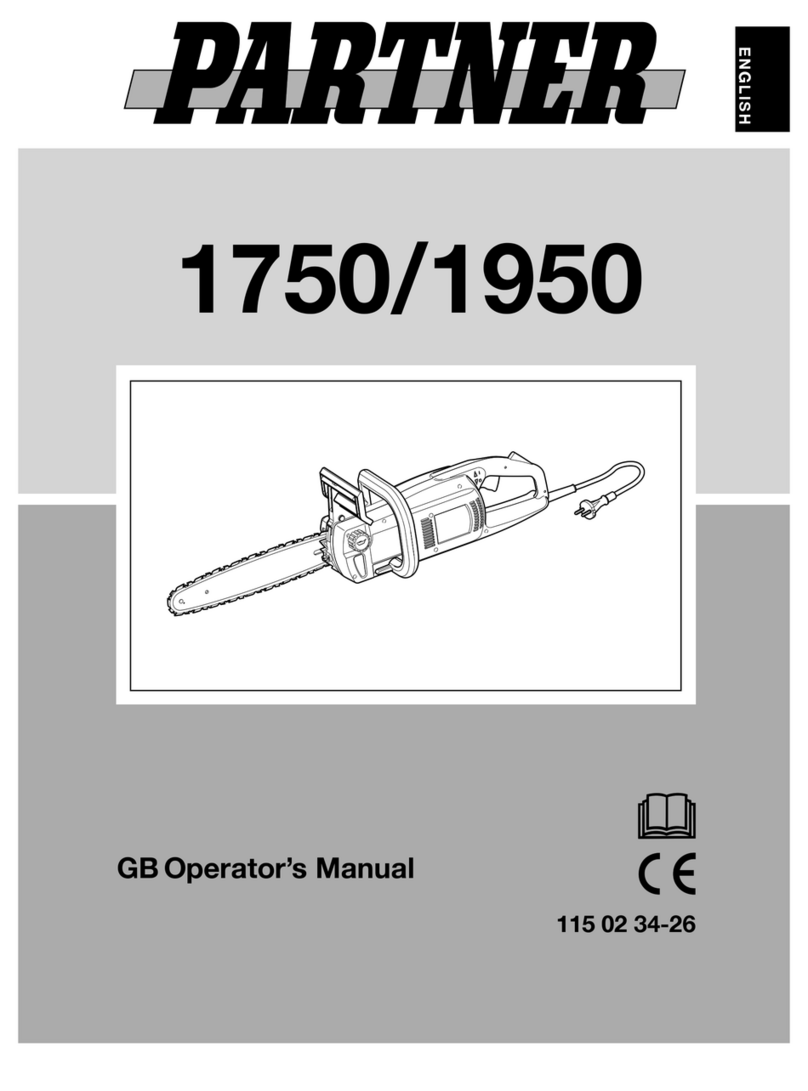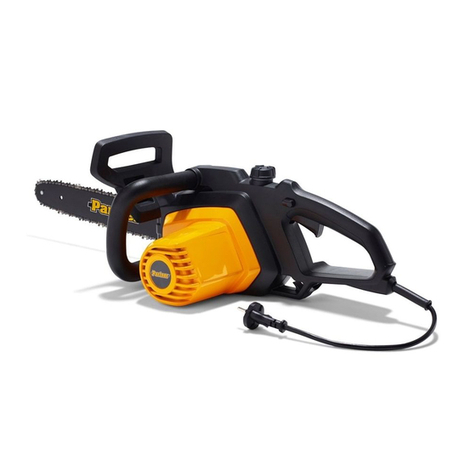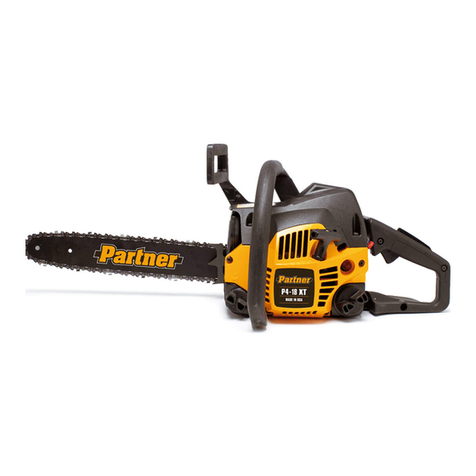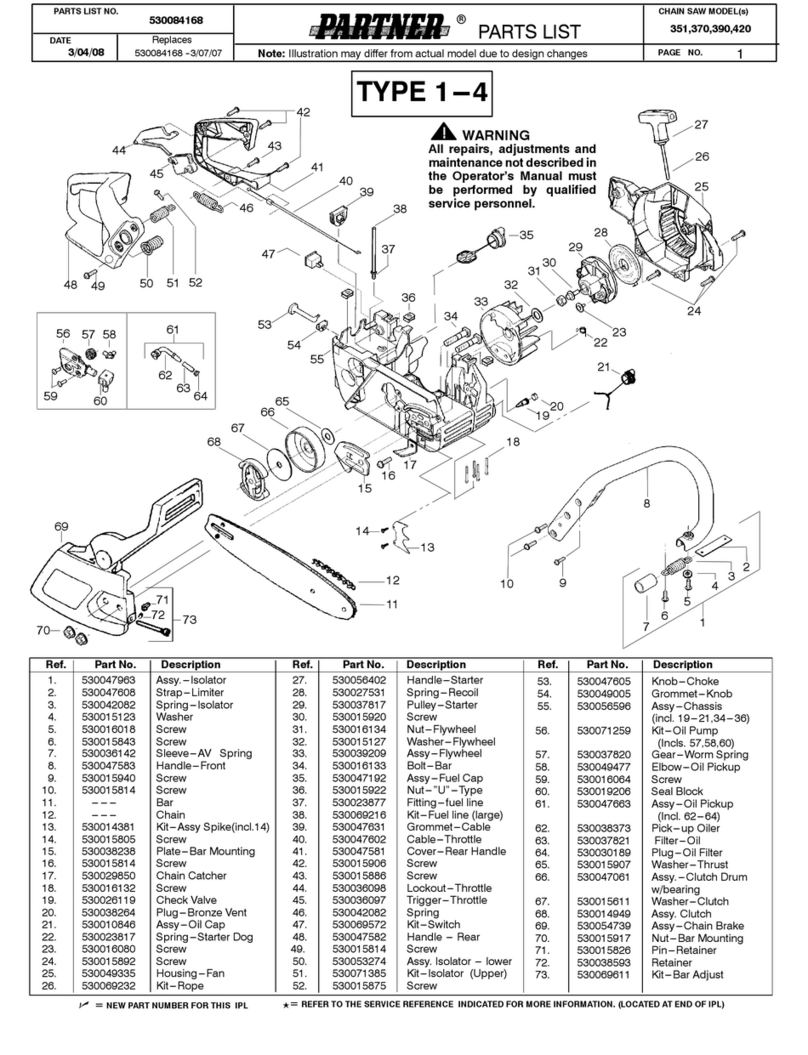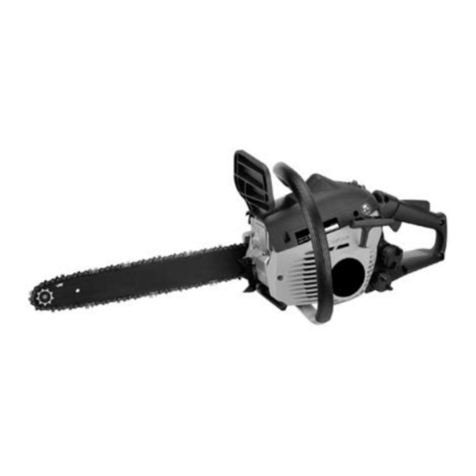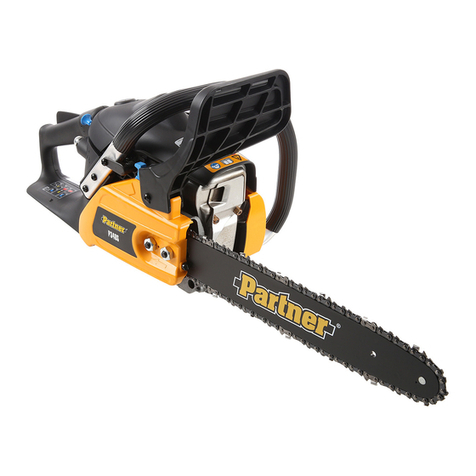-- 4 --
•Tighten the cap of oil and fuel tank to
prevent the loss of oil and fuel during
transport.
•DO NOT operate your chain saw near or
around flammable liquids or gases
whether in or out of doors. An explosion
and/or fire may result.
•Do not fill fuel tank, oil tank or lubricate
when the engine is running.
•USE THE RIGHT TOOL: Cut wood
only. Do not use the chain saw for
purposes for which it was not
intended. For example, do not use the
chain saw for cutting plastic, masonry, or
nonbuilding materials.
•The first time user should have practical
instruction in manual page 10 (barking
Saw horse) in the use of chain saw and
the protective equipment form an
experienced operator.
•Do not attempt to hold the saw with one
hand only. You cannot control reactive
forces and you may lose control of the
saw, which can result in the skating or
bouncing of the bar and chain along the
limb or log.
•Never run the chainsaw indoors.
Your chainsaw produces poisonous
exhaust as soon as the combustible
engine is started, which may be colorless
and odorless. To use this product can
generate dust, mists and fumes
containing chemicals known to cause
reproductive harm. Be aware of harmful
dust, mist (such as saw dust or oil mist
from chain lubrication) and protect your
self properly.
•Wear gloves and keep your hand warm.
Prolonged use of chainsaws exposing the
operator to vibrations may produce
whitefinger disease. In order to reduce the
risk of whitefinger disease, please wear
gloves and keep your hand warm. If any of
the whitefinger symptoms appear, seek
medical advice immediately.
•When transporting or storing the chain
saw always fit the guide bar cover.
•Drive in the spiked bumper of the chain
saw directly behind the intended hinge
and pivot the saw around this point. The
spiked bumper rolls against the trunk.
•There are 3 parts only, chain, bar and
spark plug, can be replaced by the user
themselves and please use the same
type as showed on the specifications in
the user's manual.
(Type for the plug is NGK CMR7H).
If the other components beyond the prior
parts are defective, then please take your
tools to the nearest Authorized Service
Center for service.
NOTE: This appendix is intended primarily
for the consumer or occasional user. These
models are intended for infrequent use by
homeowners, cottagers, and campers, and
for such general applications as clearing,
pruning, cutting firewood, etc. They are not
intended for prolonged use. If the intended
use involves prolonged periods of opera-
tion, this may cause circulatory problems in
the user’s hands due to vibration.
KICKBACK may occur when the NOSE or
TIP of the guide bar touches an object, or
when wood closes in and pinches the saw
chain in the cut.
Tip contact in some cases may cause a
lightning-fast reverse reaction, kicking the
guide bar up and back toward the operator.
PINCHING the saw chain along the
BOTTOM of the guide bar may PULL the
saw forward away from the operator.
PINCHING the saw chain along the TOP of
the guide bar may PUSH the guide bar
rapidly back toward the operator.
Any of these reactions may cause you to
lose control of the saw, which could result in
serious personal injury.
KICKBACK SAFETY PRECAUTIONS
1. With a basic understanding of kickback,
you can reduce or eliminate the element
of surprise. Sudden surprise contributes
to accidents.
2. Keep a good firm grip on the saw with
both hands, the right hand on the rear
handle, and the left hand on the front
handle, when the engine is running. Use
a firm grip with thumbs and fingers
encircling the chain saw handles. A firm
grip will help you reduce kickback and
maintain control of the saw. Don’t let go.
3. Make sure that the area in which you are
cutting is free from obstructions. Do not
let the nose of the guide bar contact a
log, branch, or any other obstruction
which could be hit while you are
operating the saw.
4. Cut at high engine speeds.
5. Do not overreach or cut above shoulder
height.
6. Follow manufacturer’s sharpening and
maintenance instructions for the saw
chain.
7. Only use replacement bars and chains
specified by the manufacturer or the
equivalent.
NOTE: Low-kickback saw chain is chain
that has met the kickback performance.
